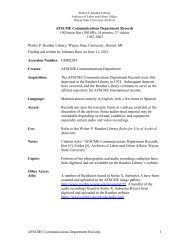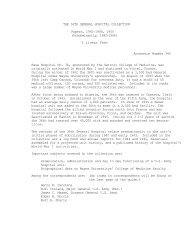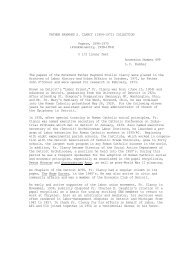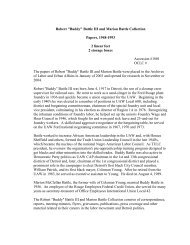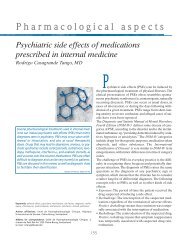Human Modeling Lab - Wayne State University
Human Modeling Lab - Wayne State University
Human Modeling Lab - Wayne State University
Create successful ePaper yourself
Turn your PDF publications into a flip-book with our unique Google optimized e-Paper software.
About<br />
Advanced <strong>Human</strong> <strong>Modeling</strong> <strong>Lab</strong> / Biomedical Engineering — Bioengineering / <strong>Wayne</strong> <strong>State</strong> <strong>University</strong><br />
In 2000, injuries in the United <strong>State</strong>s resulted in<br />
149,000 fatalities with 50 million people required medical<br />
attention. The leading cause of fatal injuries is motor<br />
vehicle crashes. Presently, anthropomorphic test<br />
devices (ATDs) are commonly used to evaluate vehicular<br />
safety systems. Unfortunately, ATDs exhibit significant<br />
deficiencies when predicting real world human<br />
injuries. With the rapid advancement in computing technology,<br />
we envision that human responses in activities<br />
ranging from those of daily living to high-speed motor<br />
vehicle crashes can be simulated quickly with accuracy.<br />
The Advanced <strong>Human</strong> <strong>Modeling</strong> <strong>Lab</strong>oratory of the<br />
Bioengineering Center have developed detailed finite<br />
element models of human body from head to toe since<br />
the early 1990’s. These models have been validated<br />
against existing<br />
cadaveric data at<br />
global and local<br />
levels. The<br />
model has been<br />
used to predict<br />
human responses<br />
in various impact<br />
environments to<br />
further understand<br />
injury mechanisms<br />
and predict the risk of many specific injuries.<br />
WSU <strong>Human</strong> Body Model<br />
The WSU head injury model simulates all essential<br />
anatomical features of the human head and face. The<br />
model consists of a total of over 335,000 elements.<br />
The model has been validated against intracranial pressure,<br />
brain/skull relative displacement and facial impact<br />
test data. The model is well suited for simulating a<br />
range of dynamic loadings causing bony, soft tissue,<br />
vascular and neural injuries.<br />
The WSU neck model simulates all the bony structures, articular<br />
surfaces, relevant ligaments and intervertebral discs.<br />
The model has been validated against quasi-static loading,<br />
near vertex drop and rear impact. The WSU thorax–shoulder<br />
model includes a detailed description of the organs in the<br />
chest, a finely meshed aortic structure and a detailed shoulder.<br />
The model has been validated against frontal and lateral<br />
impact and side airbag deployment tests. The WSU abdomen<br />
model simulates both solid and hollow organs of the human<br />
abdomen. The model has been validated against cadaveric<br />
pendulum impact, drop test and seatbelt loading data. The<br />
WSU lower limb model includes anatomical components<br />
from hip to toe with detailed ankle and knee. The model has<br />
been validated at the segmental and the full limb levels.<br />
Injury Mechanisms<br />
Traumatic brain injury: Traumatic brain injury (TBI) is a leading<br />
cause of death and disability in the United <strong>State</strong>s. Numerical<br />
reconstruction of head impact occurred during the NFL<br />
games provided a unique means to compare simulated brain<br />
responses with physician determined signs and symptoms and<br />
to investigate tissue-level mechanisms for concussive injury.<br />
The results showed that strain and strain-rate responses in<br />
specific regions of the brain and phases of the response correlate<br />
with return to play, cognitive<br />
and memory problems. These<br />
correlations imply that FE models<br />
and strain-related injury criteria<br />
offer new insights into the timing of<br />
concussion injuries and affected<br />
locations. The helmet designed to<br />
reduce strain effect after primary<br />
impact would be an important new<br />
focus for research.<br />
Noninjury Concussion<br />
Striking<br />
Struck<br />
Neck injury in rollover crash: In the United <strong>State</strong>s,<br />
rollover-related fatalities accounted for more than onethird<br />
of all deaths from passenger vehicle<br />
crashes. The neck model has been<br />
used to investigate the injury mechanism<br />
during rollover crashes. Different seat<br />
belt designs as well as the roof interior<br />
designs can be evaluated and optimized<br />
during different rollover scenarios.<br />
Aorta rupture in side impact: Traumatic rupture of<br />
the aorta (TRA) is the second most common cause of<br />
fatality in automotive crashes. The rate of TRA in nearside<br />
crashes is twice that in frontal crashes. The aortic<br />
tears are commonly found in the peri-isthmic region<br />
and nearly transverse to the longitudinal axis of the<br />
aorta. By simulating the real world crash cases with<br />
human model, injury mechanisms of the TRA is elucidated<br />
and local aortic stress and strain patterns is<br />
linked to the clinically<br />
seen rupture.<br />
Shoulder injury in side impact:<br />
Previous studies have hypothesized<br />
that engaging the shoulder<br />
may reduce chest injury in side<br />
impact. The shoulder model has been used to understand<br />
the interaction between the shoulder and the<br />
thorax. During side impact, the shoulder do appear to<br />
uptake some of impact energy, however, the protection<br />
of the acromio-clavicular joint is needed before shoulder<br />
can provide protection to the ribcage.



